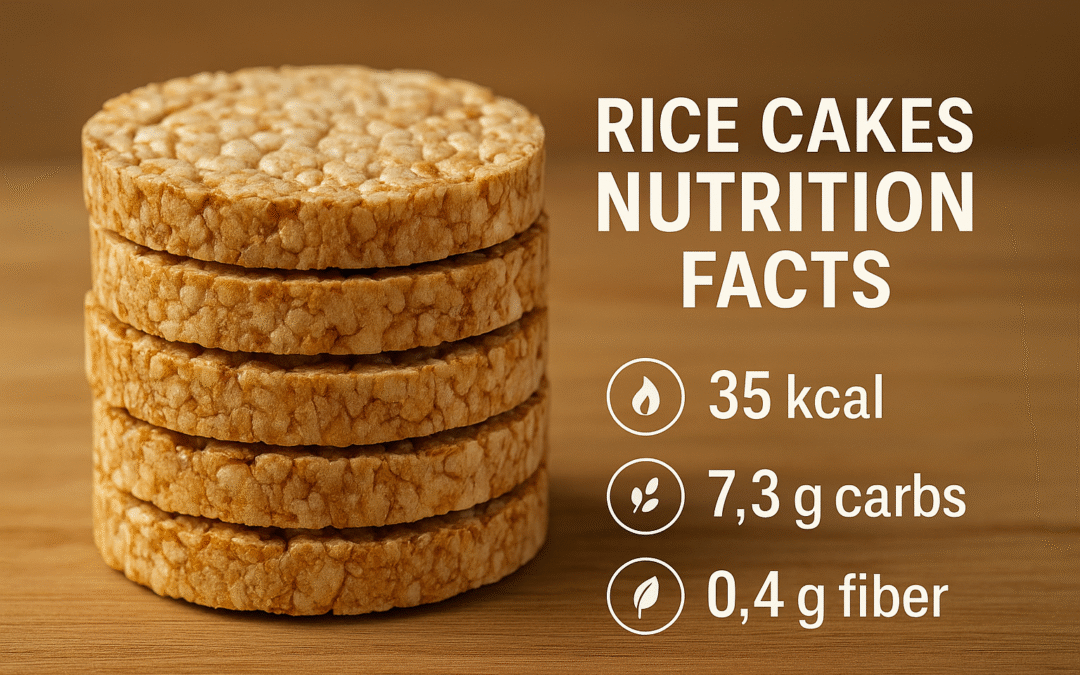Disclaimer
Nutritional values are approximate and may vary by brand and flavor. This article is for informational purposes only and not a substitute for professional dietary or medical advice.
Light, crunchy, and often marketed as a “healthy snack,” rice cakes have become a staple for those looking to cut calories or replace traditional chips and crackers. But are they truly nutritious, or just puffed air with flavor?
Understanding rice cakes nutrition facts helps separate marketing claims from real dietary value. While they’re low in calories, they often lack the protein, fiber, and vitamins needed to keep you full for long. This article breaks down what’s inside rice cakes, their benefits, drawbacks, and how to include them wisely in your diet.
What Are Rice Cakes?
Rice cakes are made by puffing grains of rice under high heat and pressure until they fuse together into light, crunchy discs.
They can be made from:
- White rice: Lighter texture, lower in fiber
- Brown rice: Contains more nutrients and fiber
- Whole-grain blends: May include quinoa, millet, or corn
Flavored versions often include salt, sugar, or coatings like caramel or cheese powder. Because ingredients vary widely, their nutritional value can differ depending on brand and preparation.
Rice Cakes Nutrition Facts (Per 1 Plain Brown Rice Cake – 9 g)
| Nutrient | Amount |
|---|---|
| Calories | 35 kcal |
| Total Fat | 0.3 g |
| Saturated Fat | 0 g |
| Carbohydrates | 7.3 g |
| Sugars | 0 g |
| Dietary Fiber | 0.4 g |
| Protein | 0.7 g |
| Sodium | 2 mg |
| Potassium | 26 mg |
| Iron | 0.1 mg |
| Calcium | 1 mg |
| Magnesium | 12 mg |
| Phosphorus | 33 mg |
| Zinc | 0.3 mg |
Values are based on plain, unsalted brown rice cakes. Flavored versions can have higher sodium and sugar levels.
Calories in Rice Cakes
A single plain rice cake contains around 35 calories, making it a low-calorie snack. However, its light texture means it’s easy to overeat — three or four cakes can quickly add up to 140 calories without much satiety.
Brown rice cakes generally have slightly higher calories but offer more fiber and minerals than white rice versions.
Carbohydrates and Glycemic Index
Rice cakes are primarily made of carbohydrates — about 7–8 grams per piece. Most are simple carbs that digest quickly and can cause a rapid rise in blood sugar, especially when eaten alone.
Rice cakes have a high glycemic index (GI) of around 70–80, meaning they can cause quick spikes in blood glucose. For people with diabetes or insulin resistance, this makes portion control and food pairing important.
Tip: Pair rice cakes with a protein or fat source like nut butter, hummus, or avocado to balance the glycemic impact.
Fiber Content
Plain white rice cakes are very low in fiber (less than 0.5 g per piece), while brown rice cakes offer slightly more — around 1–1.5 g per serving (3–4 cakes).
Fiber helps slow digestion, stabilize blood sugar, and improve satiety. If you enjoy rice cakes regularly, opt for whole-grain or brown rice varieties to get a modest fiber boost.
Protein Content
Rice cakes are low in protein, with less than 1 gram per cake. Because protein supports muscle repair and keeps you full, eating rice cakes alone may leave you hungry soon after.
To make them more balanced:
- Add peanut butter or almond butter for plant-based protein
- Top with tuna, hummus, or cottage cheese
- Pair with boiled eggs or a protein smoothie
This combination turns a light snack into a more substantial mini-meal.
Fat and Sodium
Plain rice cakes are virtually fat-free and low in sodium, making them suitable for low-fat diets. However, flavored versions (cheddar, caramel, sea salt) can contain:
- 2–3 grams of fat (from oil or flavor coatings)
- 100–200 mg of sodium per cake
Always check labels — the difference between a plain and flavored rice cake can be significant in terms of salt and added oils.
Vitamins and Minerals
Rice cakes are not nutrient-dense foods. They provide trace minerals but lack substantial amounts of vitamins.
| Nutrient | Benefit | Amount |
|---|---|---|
| Magnesium | Supports energy and muscle health | 12 mg |
| Phosphorus | Strengthens bones | 33 mg |
| Zinc | Supports immune function | 0.3 mg |
| Potassium | Regulates blood pressure | 26 mg |
| Iron | Helps oxygen transport | 0.1 mg |
Whole-grain rice cakes retain slightly more nutrients than those made from refined white rice.
Gluten-Free Nature
Rice cakes made from pure rice are naturally gluten-free, making them safe for individuals with celiac disease or gluten intolerance.
However, cross-contamination can occur in processing facilities, so it’s best to look for certified gluten-free labels if you have sensitivities.
Are Rice Cakes Healthy?
Rice cakes can be considered healthy in moderation, especially when made from whole-grain brown rice and eaten with nutritious toppings. They’re:
- Low in calories
- Free of added sugars (when plain)
- Convenient and shelf-stable
However, they’re also:
- Low in protein, fiber, and fat
- High in glycemic index
- Lacking key micronutrients
So while rice cakes are not “unhealthy,” they’re not complete snacks on their own. They’re best viewed as a base for nutrient-rich toppings.
Flavored vs Plain Rice Cakes
| Type | Calories | Sugar | Sodium | Fiber | Notes |
|---|---|---|---|---|---|
| Plain Brown Rice Cake | 35 kcal | 0 g | 2 mg | 0.4 g | Best for balanced diets |
| Caramel Rice Cake | 50 kcal | 3 g | 70 mg | 0.3 g | Higher sugar content |
| Cheddar Rice Cake | 45 kcal | 1 g | 180 mg | 0.4 g | High in sodium |
| Chocolate-Coated | 60–70 kcal | 5 g | 60 mg | 0.5 g | Dessert-style option |
Choose plain or lightly salted versions when possible, and add natural toppings for flavor.
Health Benefits of Rice Cakes
1. Low-Calorie Option
Rice cakes can help with portion control when compared to fried or baked snacks. A few cakes can replace chips or crackers at half the calorie count.
2. Quick Digestibility
They’re gentle on digestion, making them a good choice during illness, travel, or post-workout recovery when you need easy-to-digest carbohydrates.
3. Gluten-Free Snack
Ideal for those with gluten intolerance or celiac disease when made from certified gluten-free rice.
4. Customizable Base
Their neutral flavor makes them versatile — pair them with sweet or savory toppings for balanced nutrition.
Drawbacks of Rice Cakes
1. Low Nutritional Density
Rice cakes offer minimal vitamins, minerals, and fiber compared to other whole-grain snacks.
2. High Glycemic Index
They can spike blood sugar when eaten alone, especially in individuals with diabetes or insulin resistance.
3. Lack of Satiety
Because they’re light and low in fat/protein, rice cakes may not keep you full for long.
4. Added Sugars and Sodium in Flavored Versions
Processed varieties may contain artificial flavors, sweeteners, and preservatives that reduce their nutritional quality.
How to Make Rice Cakes More Nutritious
You can easily turn rice cakes into balanced snacks by pairing them with nutrient-rich ingredients.
For a healthy breakfast:
- Rice cake + peanut butter + banana slices
- Rice cake + avocado + boiled egg
- Rice cake + Greek yogurt + berries
For a savory snack:
- Rice cake + hummus + sliced cucumber
- Rice cake + tuna salad + black pepper
- Rice cake + smoked salmon + cream cheese
For a sweet option:
- Rice cake + almond butter + honey drizzle
- Rice cake + ricotta + cinnamon
- Rice cake + dark chocolate spread + strawberries
Combining protein, fiber, and healthy fats balances blood sugar and keeps you satisfied longer.
Rice Cakes and Weight Management
Because they’re low in calories, rice cakes can fit easily into a weight-loss plan, but the key is how you use them.
Eating rice cakes plain may lead to hunger soon after, prompting overeating. Instead, pair them with healthy fats or protein sources to create a sustainable, balanced snack.
When used as part of a structured diet, they can help control portion size and replace higher-calorie refined carbs.
Rice Cakes vs Other Snacks
| Snack | Calories | Protein | Fiber | Sodium | Notes |
|---|---|---|---|---|---|
| Rice Cake | 35 kcal | 0.7 g | 0.4 g | 2 mg | Light, low-nutrient |
| Whole Wheat Cracker | 70 kcal | 2 g | 1 g | 120 mg | More fiber, higher sodium |
| Popcorn (air-popped) | 30 kcal | 1 g | 1.2 g | 0 mg | More fiber |
| Corn Cake | 40 kcal | 0.5 g | 0.3 g | 5 mg | Similar calories |
| Oatcake | 70 kcal | 2 g | 1.5 g | 100 mg | Higher in nutrients |
Plain rice cakes remain one of the lowest-calorie snack bases, but others like popcorn or oatcakes deliver more nutrients and satiety.
Storage and Shelf Life
Rice cakes have a long shelf life when stored properly:
- Keep in a cool, dry place
- Reseal or store in airtight containers after opening
- Avoid moisture exposure to maintain crispness
They typically stay fresh for 6–8 months unopened, and 1–2 weeks after opening.
Quick Recap of Rice Cake Nutrition
| Nutrient | Amount per Cake |
|---|---|
| Calories | 35 kcal |
| Carbohydrates | 7.3 g |
| Fiber | 0.4 g |
| Protein | 0.7 g |
| Fat | 0.3 g |
| Sodium | 2 mg |
| Potassium | 26 mg |
| Magnesium | 12 mg |
The Bottom Line
Rice cakes are a simple, versatile, and low-calorie snack — great as a crunchy base but not a complete source of nutrition.
They can fit into a healthy diet when paired with protein, fiber, or fat-rich foods to balance their high glycemic index. Choose whole-grain brown rice cakes over white or flavored versions for better nutrition and fewer additives.
In moderation, rice cakes offer a convenient alternative to processed snacks — but they’re best seen as a blank canvas, not a standalone meal.

